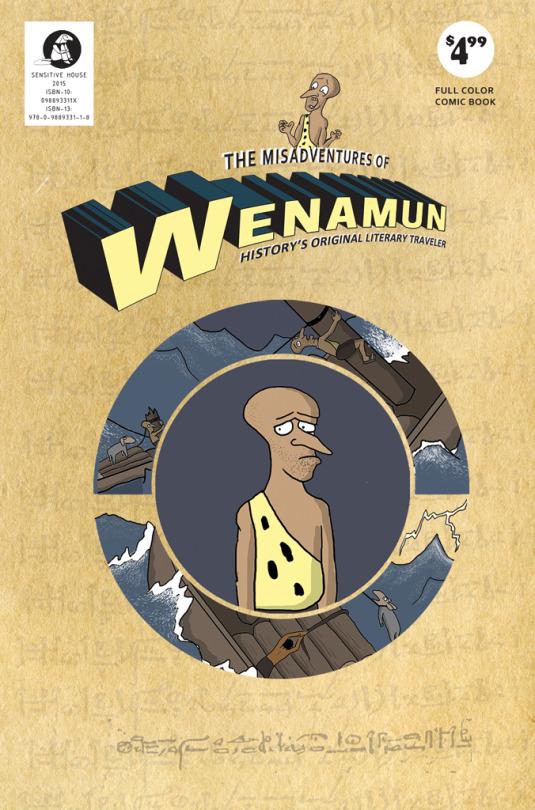https://www.yahoo.com/travel/the-first-worst-tourist-a-3000-year-old-travel-129230521682.html
The First Worst Tourist: A 3000-Year-Old Travel Tale

The author’s comic book. (Photo: Courtesy of Rolf Potts)
When
compared to Odysseus or Herodotus, Wenamun doesn’t seem like much of a
traveler — at least not by the heroic standards of ancient literature.
In the papyrus tale that bears his name, Wenamun, an inept Egyptian
priest who journeyed across the eastern Mediterranean to acquire
Lebanese lumber more than 3000 years ago, does not come off as a leader
of men. He doesn’t discover new lands, nor does he outwit sea monsters,
or even offer any hard-won insights into the cultures he visits. For the
most part, the ancient Egyptian sojourner makes one boneheaded travel
blunder after another.
In
Lower Egypt, for instance, Wenamun misplaces his priestly letter of
introduction (the Ramses XI-era equivalent of losing his passport), a
gaffe that catches up with him later in the journey. Along the Levantine
coast, in the port city of Dor, his gold and silver gets stolen by one
of his own sailors. And, after a series of humiliating fiascoes stemming
from an ill-considered display of arrogance toward his Lebanese hosts,
he ultimately breaks down weeping and yearns to go home.

From the comic book. (Photo: Courtesy of Rolf Potts)
Far
from an intrepid adventurer, Wenamun is for all appearances as hapless
as any modern tourist — and that is exactly what makes him fascinating.
“To me the tale of Wenamun is great because it gives a vivid, first-hand
sense of the frequent tedium and difficulties of most travel in ancient
times,” says T.G. Wilfong, a professor of Egyptology at the University
of Michigan. “The story gives us a vivid picture of Egypt and its ambiguous place in the ancient Mediterranean world at the time.”
When I first read a summary of Wenamun’s journey in Lionel Casson’s Travel in the Ancient World
a few years ago, I was struck by two things: First, that an ancient
travel tale could be so self-deprecatingly goofy; and second, that I’d
never heard of it before, even after years of reading and writing about
travel. Familiar as I was with ancient epics that featured supernatural
heroism, uncommon bravery, and military conquest, I was surprised — and
delighted — to find a travel protagonist so foolish and fallible and,
well, relatable.
Why
is it, I wondered, that most modern readers had never heard of Wenamun?
It could have been because his travel tale is episodic and fragmentary,
and doesn’t feature a concrete ending. It could also have been due to
the fact that the tale was lost to history until the late 19th century,
when it was discovered by Russian Egyptologists (whose work was
underreported in the Anglophone world).
As
much as anything, however, the story of Wenamun has likely been
overlooked because it doesn’t flatter the reader with a
self-congratulatory vision of cultural heroism. Written at a time when
Egyptian power in the eastern Mediterranean region was on the wane, it
has a decidedly postcolonial tone, lampooning (rather than glorifying)
the deeds of its peripatetic protagonist.

The author and illustrator (Photo: Luke Van Tassel)
After
reading various translations of the story, I sensed that modern
audiences might better appreciate the cadences and twists of this tale
if it were retold, in more fanciful form — not as a scholarly document,
but as a comic book. This in mind, I transformed the story into graphic
narrative with the help of my teenaged nephew Cedar Van Tassel, an
up-and-coming comics blogger whose youthful sensibilities lent the right amount of whimsy and impetuousness to the tale’s bumbling anti-hero.
Staying
as true as possible to the translated papyrus, we broke the tale down
into a series of panels that Cedar fleshed out in hand-drawn narrative,
first in pencil and later in ink. We called it The Misadventures of Wenamun, and a black-and-white version of the comic debuted online at The Common early last year.
Some
of the earliest fans of the comic were scholars at Oxford University’s
Griffith Institute, who used social media to share the tale with
far-flung Egyptology students and scholars. “The comic version
definitely made the story more vivid and enjoyable for me,” notes Brown
University grad student Christian Casey, who found the graphic narrative
via Facebook. “I’m a comic book nerd, and I always search the boxes at
conventions for Egypt themed comic books. So the Wenamun comic was right
up my alley.”
Earlier last year, Sensitive House Press proposed reimagining “The Misadventures of Wenamun” as a full-color comic book, with a design and feel not unlike an old postwar issue of Amazing Stories.
Aimed at comic-book fans, history buffs, armchair travelers, and
students of all ages, it debuts this month in select bookstores and is
available for online order. (All profits from the sale of the Wenamun comic are earmarked for Save the Children’s Syrian refugee initiative).
Perhaps
in time the story of Wenamun’s Egypt-to-Lebanon misadventure will be
more widely recognized for its humble contribution to the canon of
ancient travel literature. It feels fitting — if only as a cautionary
tale — in an age when the first step to meaningful travel can be
admitting to our own shortcomings as cross-cultural wanderers. “The tale
of Wenamun is one of the most accessible stories from ancient Egypt,”
says Wilfong, “a rare case when we really feel like an ancient Egyptian
is speaking directly to us.”
No comments:
Post a Comment